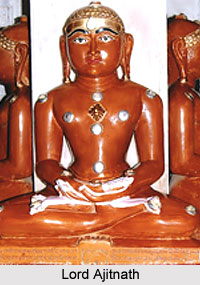 Lord Ajitnatha was the second Jain Tirthankara of the current age -Avasarpini. As per Jain philosophy, he became a siddha, an enlightened soul which has destructed all of its karma.
Lord Ajitnatha was the second Jain Tirthankara of the current age -Avasarpini. As per Jain philosophy, he became a siddha, an enlightened soul which has destructed all of its karma.
In its earlier avatar the soul that became Lord Ajitnath, was the great Emperor Vimalvahan of Susima city in Mahavideh area. He led a very religious and pious life although he received all the princely grandeur. He remained completely detached from all royal pleasures. When he grew up he became an ascetic under Arindam Suri.
Resurrection of Lord Ajitnatha
Lord Ajitnatha was born at Ayodhya in the Ikshvaku dynasty to Emperor Jitashatru Raja and Queen Vijaya. The queen saw fourteen propitious dreams. On the other hand Vaijayanti, the wife of Emperor Jitshatru`s younger brother, Sumitra, also saw the same fourteen dreams. As this was a queer coincidence the augers were consulted. According to them Vijaya Devi will give birth to a Tirthankara and Vaijayanti to a Chakravarti -Emperor.
While the queen was pregnant the influence of the baby in the womb enhanced peace and love in the region. It happened that, even the enemy kingdoms sought and negotiated friendly treaties with the king. It became a common practice to say Emperor Jitshatru is invincible, Ajit.
The queen gave birth to a son on the eighth day of the bright half of the month of Magh. The emperor named the boy as Ajit. The same night, the emperor`s brother`s wife Vaijayanti also gave birth to a son who was named Sagar. As both the princes grew they were married. Time passed with the fusion of bliss.
After ruling for many years the Emperor wished to devote the last part his life in divine practises. He thus asked his younger brother to ascend to the throne but he did not have any craving for the kingdom and wished to be an ascetic. Both the princes were called and offered the kingdom. Since childhood Ajit Kumar always remained a detached person. He thus declined to be the king since childhood, he too declined. At last prince Sagar ascended the throne.
Ascetic Life of Ajit Kumar
Ajit Kumar became an ascetic in his youth. He travelled into remote and dense forests for his meditation and penance. The intensity of his religious practices had a pacifying influence all around. The impact was such that even the enemies in the animal kingdom, like lion and cow, wolf and deer, snake and mongoose sat beside him around him serenely. After a twelve year period of rigorous meditation and other divine practices he achieved nirvana on the eleventh day of the bright half of the month of Paush. Upon achieving nirvana Lord Ajitnath gave his discourses on various religious topics. Thousands of individuals accepted the path of renunciation.
During this period Emperor Sagar, vanquished the six continents and became Chakravarti. Emperor Meghvahan and Vidyadhar Bhim, the ruler of the island of Rakshasas, demons, were the illustrious contemporaries of Emperor Sagar. Once they attended a discourse of Lord Ajitnath. Hearing the discourse Vidyadhar Bhim was drawn towards ascetic life. He became so detached that he gave his kingdom including the celebrated cities of Lanka and Patal Lanka to Emperor Meghvahan. He also gave all his knowledge and miraculous powers to him. The king also possessed a divine necklace of nine large and shining beads that he gifted to Meghvahan. He was the first Emperor of the Rakshas clan in which the famous Emperor Ravana was born.
Lord Ajitnath travelled to many places. During his last moments Lord Ajitnath went to Sarnmetshikhar. With one thousand other monks, he commenced his final meditation. He achieved Nirvana on the fifth day of the bright half of the month of Chaitra.









